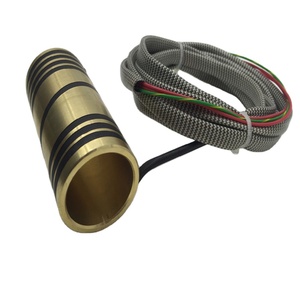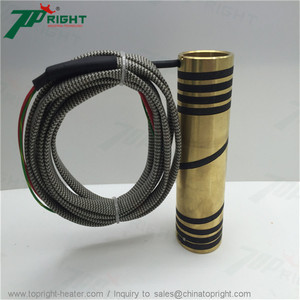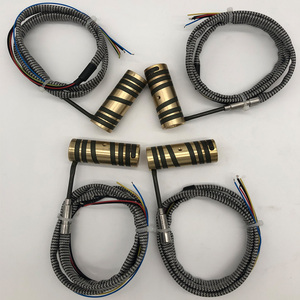
All categories
Featured selections
Trade Assurance
Buyer Central
Help Center
Get the app
Become a supplier

(2714 products available)



























Hot runner coil heaters are adaptable heating devices that manage the temperature of the hot runner in the injection mold. They are a key part of the hot runner system, ensuring a consistent temperature across the mold to make good quality plastic products. The structure of coil heaters is generally made of stainless steel that can stand high temperatures and is resistant to corrosion. They can heat different molds with their sizes and voltage variations.
Cylindrical coil heaters:
Cylindrical coil heaters are the common types of hot runner heaters. They have a cylindrical shape with a built-in resistance wire or thermal foil. When the electricity goes through the resistance wire, it gives off heat. Thermal cartridges are similar to cylindrical coil heaters but have a more extended and tapered shape. They provide concentrated heat in a specific area. Both of them are easy to fit in the mold to supply heat evenly for the whole mold.
Flexible heaters:
Flexible heaters can supply heat for the mold with an unusual shape or size. They are made of soft materials, which means they are thin and light, so they can be fitted into complex or limited spaces. Flexible heaters can also be made to have different voltages and sizes to meet specific requirements, which is another benefit.
Zone-controlled heaters:
Zone-controlled heaters can supply different quantities of heat for different areas on the same heater. Usually, they will have several heating areas that are evenly distributed across the hot runner. Each heating area can reach an individual heating power, which can meet the diverse requirements of different areas of the hot runner.
The specifications for hot runner coil heaters vary depending on the type and application. Here are some standard specifications and their meanings.
Sizes
Coil heater sizes usually include the length, diameter and wattage. The measurements are essential as they affect how well the heater works and whether it can fit particular equipment. For example, larger coil heaters may be needed to heat bigger molds. Also, adjustments to the size of the coils could change how much energy the heater uses.
Voltage
Coil heater voltage indicates the amount of electrical power needed to run the heater. It affects the level of heat produced. Different applications may require specific voltage levels to work efficiently.
Watt density
This is the measure of power output per unit area of the coil heater. A higher watt density coils generate more heat quickly but may overheat if not properly controlled. It influences heating response time and heating uniformity.
Thermal Conductivity
This refers to the ability of a material to conduct heat. Materials with high thermal conductivity rapidly spread heat throughout the mold, reducing cycle times and improving product quality. Low thermal conductivity results in uneven heating and longer cycle times.
Resistance wire
It is wire designed to resist the flow of electric current. The resistance generates heat, which is transferred to the coil to provide the required temperature. The diameter and length of the wire affect the resistance value and the amount of heat produced.
Surface finish
The surface finish of a coil heater affects heat transfer. A rough surface enhances heat transfer, while a smooth surface reduces it. Also, the surface finish impacts mold release and product quality.
With proper care, the hot runner coil heats up quickly and maintains the temperature for a long time. Here are a few tips to keep it working well.
These types of heater coils are hot runners in the injection molding industry, commonly used in the following areas:
Sustaining Temperature in Molding Cavity
Using a hot runner coil heater to maintain temperature consistency within the molding cavity is a common practice. This is crucial for achieving uniform melts of materials, which in turn enables precise molding of plastic products.
Multi-Component Molding
Hot runner coil heaters are beneficial when molding products composed of multiple materials. They facilitate the simultaneous molding of different materials, such as combinations of plastics with varying characteristics or blends of plastics and other substances.
Molding Complex Geometries
When attempting to mold intricate shapes and design details, hot runner coil heaters prove valuable. These highly detailed molds often necess precision control of material flow and temperature in order to achieve the desired results.
Reducing Production Cycle Time
One way hot runner coil heaters can help decrease production time is by shortening the cooling time for molded products. Their ability to maintain high temperatures in the molding cavity results in faster cooling of molded products and increased production efficiency.
Streamlining Molding Process
Hot runner coil heaters can simplify the molding process by eliminating the need to purging and cleaning excess material that accumulates in cold sprues. This can reduce downtime and enhance production efficiency.
Injection Molding
Hot runner coil heaters are primarily used in injection molding machines, which are extensively employed in the plastic processing industry. These machines utilize hot runners as standard components for efficient and high-quality molding operations.
These tips will help buyers to choose the right hot runner coil heaters.
Application Needs Assessment:
Buyers should evaluate their specific application requirements to determine their needs. This includes considering the type of material they'll be working with, the level of precision and uniformity required for heating, and the size and weight limitations of the heating elements. Additionally, they'll need to assess the temperature range and control capabilities necessary for their particular application. Taking the time to thoroughly assess these factors will ensure that they choose coil heaters that are well-suited to their unique needs, resulting in effective and efficient heating performance.
Quality and Reliability:
When selecting hot runner coil heaters, it's crucial to prioritize dependable suppliers who offer high-quality products. Opt for coil heaters constructed from premium materials, designed to withstand the rigors of demanding applications. Select heating elements demonstrating durability, reliability, and consistent performance. By choosing quality coil heaters, buyers can enjoy long-lasting and efficient heating solutions.
Size and Power Rating Compatibility:
To ensure proper functionality and performance, buyers must consider the size and power rating of hot runner coil heaters in relation to their specific applications and equipment. Selecting coil heaters that are compatible with their systems helps to prevent any potential issues that may arise from incompatible heating elements. By choosing the right size and power rating, buyers can guarantee optimal heating effectiveness and efficiency within their equipment and applications.
Q: What is the difference between a heated band and a heater coil?
A: Hot coils installed in molds are the main element of hot runner systems, while heaters bands are usually wrapped around barrels or other cylindrical objects to provide heating. Both of them are designed for the same purpose, to provide heat but in different applications.
Q: How is the heat supplied to the coil heater?
A: In a coil heater, electricity is the main source of energy. The coil is usually linked to a temperature control device that can adjust the amount of electricity flowing to the coil. Other than that, some types of heaters can also receive gas or liquid fuel.
Q: What are the maximum temperature and watt density of the coil heater?
A: The maximum temperature of a coil heater can range from 200 to 1,000 degrees Celsius, while the watt density can be as low as 5 watts per square inch or as high as 100 watts per square inch.
Q: Are coil heaters customizable?
A: Yes, many manufacturers offer customized options for size, shape, voltage, wattage, and termination type to meet specific applications.